How to grow onion: planting and care in open ground before winter
There are about 600 varieties of onions in the world. Among them there are spicy and sweet varieties grown for turnips and green feathers. The latter includes the spring onion, which produces aromatic, semi-sharp greens. This type of onion is sown 2-3 times per season - in spring, summer and autumn with seeds.
Increased resistance to severe frosts allows planting before the onset of frost and harvesting the first harvest in early spring. From this material you will learn everything about planting spring onions before winter and caring for them in the open ground.
Is it possible to plant spring onions before winter?
Onion is characterized by increased frost resistance, which allows you to plant it in late autumn before winter to obtain early greenery at the beginning of spring. This planting method has more advantages than disadvantages.
Advantages and disadvantages of the method
Pre-winter planting of onions is characterized by a number of advantages:
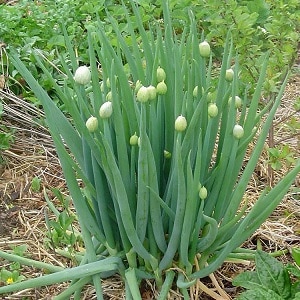 early harvest;
early harvest;- there is no need to weed and loosen the beds;
- the risk of infection of plantings is minimized due to the fact that the winter plant grows stronger than the spring one;
- space with nutritious soil is freed up for planting tomatoes or cucumbers after the onion harvest.
Among the disadvantages of winter sowing batuna have an increased risk of seed death during severe frosts and winters with little snow. However, insulating the area with agrofibre helps preserve the plantings.
Suitable varieties
Late-ripening varieties are best suited for planting batun before winter.. They produce greens in 150-180 days and are highly productive. From 1 sq. m manages to collect 2-3 kg of green feathers.
The best late-ripening varieties:
- May. Winter-hardy (withstands up to -45°C), highly branched. The leaves are dark green with a rich waxy coating. In spring, the feather grows late. From the moment of germination to full ripeness, 45-50 days pass. The plant throws out arrows up to half a meter high. In the second year it forms up to five stems. The taste is spicy, spicy, sweet.
- Gribovsky. High-yielding, perennial, branched plant. Green feathers sprout slowly. The onion head is almost invisible from the ground. From the moment of sowing until the first greenery appears, 60-65 days pass. The leaves are erect, 40 cm long, falling without support. The taste is slightly spicy with a slight bitterness and a persistent onion smell.
- Seryozha. The growing season is 80-110 days. The taste is semi-sharp. Green feathers are delicate, thin, sweet, up to 1.5 m high. The plant forms a white bulb.
- Ishikura long white. The growing season is 100-110 days after germination. The stems are erect, up to 55 cm high, dark green in color with a strong waxy coating. False stem without anthocyanin coloration. The taste is pleasant, semi-sharp.
- Early meal. The growing season is 100-110 days after germination. The stems are erect, 40-45 cm high, dark green in color with a faint waxy coating. The taste is sweetish, slightly spicy.
In Russia, onions are often called “Tatarka”, since it was brought by the Mongol-Tatars.
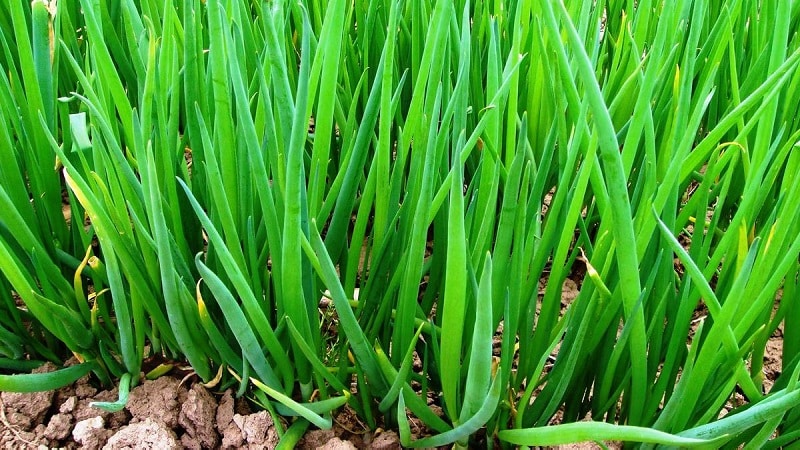
When to sow
Planting dates determined taking into account the weather conditions of each region or according to the lunar calendar.
Favorable days according to the lunar calendar
Sowing of seeds is carried out in October - November before the onset of persistent frosts.
Sowing dates for 2019:
- October: 1-5, 8-11, 15-17, 21, 29-31;
- November: 1-3, 5-8, 11-13, 17, 20, 27-30.
Sowing dates for 2020:
- October: 1, 4, 6, 8, 10, 14, 17-23, 26,27, 31;
- November: 2, 4-6, 12, 16-19, 22, 24-30.
Suitable weather conditions for sowing
Batun is sown up to three times per season: in April, June, October and November. Sowing work is carried out before the onset of stable frosts. The optimal temperature during the day is +4…+5°С.
Crop rotation rules
 Onion planted after white and cauliflower, broccoli, tomatoes, peas, beans, zucchini, eggplant, flax, lupine, oats. Bad predecessors are garlic, carrots and onions.
Onion planted after white and cauliflower, broccoli, tomatoes, peas, beans, zucchini, eggplant, flax, lupine, oats. Bad predecessors are garlic, carrots and onions.
Batun refers to perennial crops and is capable of producing greens for 7-10 years. However, the quality of the crop decreases. Peak fertility occurs 3-4 years after the first sowing. After another year, a decrease in yield is observed. Therefore, 4-5 years after planting the batun, a new bed is created and the seeds are sown again.
Thus, it is possible to replace low-yielding plantings with new ones. Seeds are collected from the old bed, dried, processed and sown. Such crop rotation does not require cash investment.
Preparation
Planting onions before winter begins with preparatory work: seed dressing, plowing and fertilizing the area.
Soils
The area for sowing onions is plowed with half a bayonet shovel.. Deep digging does not make sense due to the compact root system.
The crop can grow in the same place for several years in a row without loss of productivity. Therefore, you do not have to prepare the soil for planting every year. It is enough to fertilize the soil with nitrogen, potassium and phosphorus once every five years.
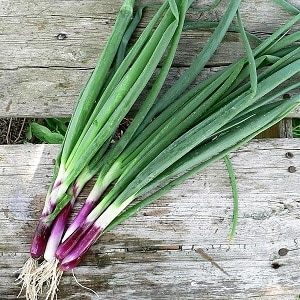 For 1 sq. m of soil is added:
For 1 sq. m of soil is added:
- 3-6 kg of humus or 30-40 g of urea or ammonium nitrate per 1 sq. m;
- 20 g of potassium chloride or 40 g of superphosphate.
Clay soil is lightened with sand - 3 kg per 1 sq. m or 200 g of wood ash per 1 sq. m.
Acidic soil is deoxidized with dolomite flour - 400-500 g per 1 sq. m.
Planting material
Before sowing, seeds are disinfected in a pink solution of potassium permanganate for 20 minutes, then fill with clean water for 24 hours. Change the water 2-3 times.
To stimulate germination after snow melts and increase protective forces, the material is treated with succinic acid, Epin or Zircon. After soaking, the seeds are not washed and dried until they flow.
How to sow correctly
After applying fertilizer, the bed is leveled and furrows are formed at a distance of 15-20 cm.
Sowing depth depends on the soil:
- in light, sandy and loamy soils, seeds are buried 3 cm;
- into a heavy, clogged one - to a depth of 2 cm.
Sowing the trampoline too deeply makes it difficult sprouting greenery in spring.

The culture is highly frost-resistant, therefore even severe frosts do not threaten it, provided that the sowing dates are observed. However, experienced gardeners advise covering the beds with mulch - peat, hay, straw, dry branches or leaves, and sawdust. This coating prevents deep freezing of the soil.
With the arrival of the first ground frosts, the area is additionally covered. black agrofibre. Non-woven fabric actively absorbs ultraviolet radiation and promotes rapid thawing of the soil in spring.
How to care for plantings
After completion of sowing work and bed covers you can exhale and relax. With the arrival of spring, when the snow melts, agrofibre and mulch are removed. The first shoots appear after 5-6 days.Grown onions are immediately thinned out, since thickened plantings will cause low yields.
In spring, the batun slowly grows green feathers. To stimulate protective forces and activate growth, plantings are watered with Epin or Zircon.
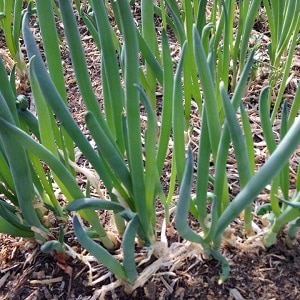 Further care includes:
Further care includes:
- Control the moisture level, watering the plantings as needed, taking into account the high moisture needs of young plants. The soil is shed to a depth of about 20 cm. During drought, the batun is watered every other day. In weather with moderate temperatures, watering is carried out with warm water twice a week at the root.
- Regular loosening of the beds after rain and watering and weeding as weeds grow.
- In the first year after sowing the batun, there is no need to apply fertilizer before winter. It is permissible to dust the beds with wood ash to increase plant productivity and protect against insects. Subsequently, the plantings are fertilized with mullein (1:10) or chicken droppings (1:15).
Protection from diseases and pests
Onions are susceptible to downy mildew (downy mildew). The leaf blade is covered with a gray-violet moldy coating. Plant growth stops.
Rust on green feathers appears as yellow round spots. The marketability of greenery deteriorates significantly, leaves die off and yields decrease.
For prevention and treatment diseases they use preparations with copper: “HOM”, “Oxychom”, copper sulfate, 1% solution of Bordeaux mixture. 2-3 treatments are enough.
The onion beetle is often attacked by the onion leaf beetle.. Adults overwinter in the soil, and in early spring they rise to the surface and begin to actively feed on young greenery. The adult beetle is 6-7 mm long and has an oblong shape. The color is orange-red, the antennae and eyes are black, and the limbs are red.The larva is thick, convex, dirty yellow in color.
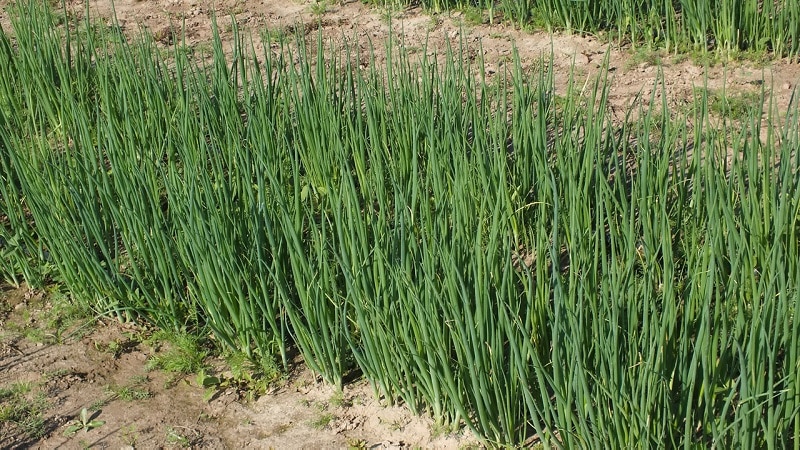
Adult onion weevils piercing a feather and suck out the juice. Weevil larvae burrow into greenery and feed on plant tissue.
Larvae onion fly They eat the bulbs, which leads to wilting and yellowing of the plant.
Onion sneaker winters under plant debris and lumps of soil. It comes to the surface after the snow melts. It feeds on young green feathers of batun. The damage is caused by larvae and beetles. The damage looks like needle pricks, closely spaced along the leaf.
It is not recommended to use strong chemicals for processing onions.. Green mass actively accumulates toxic substances, so its consumption leads to poisoning of the body.
Diseases and insect attacks are easier to prevent using such methods:
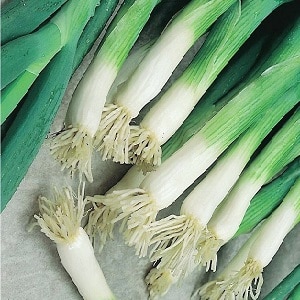 Sowing onions in the same area no earlier than after 4 years.
Sowing onions in the same area no earlier than after 4 years.- Growing crops on fertile soil.
- Compliance with the regime of watering and loosening the beds.
- Timely removal of weeds - most insects lay eggs in weeds.
- Removing sick, dead and damaged plants from the site - they spread infectious diseases.
- Use healthy planting material from the manufacturer for sowing and preventive treatment of manually collected seeds with a solution of potassium permanganate.
- Use of deterrents: potatoes treated with creolin or creosote, mulching beds with peat, dusting with tobacco shag and ash.
- Watering the roots with tobacco decoction. Infuse 1 kg of fresh or 500 g of dry raw materials in 10 liters of boiling water for 12 hours, dilute with clean water 20-30 times, add 30 g of laundry soap shavings.
Harvest and storage
The first harvest is harvested after the feather reaches a length of 25-30 cm. 45 days after planting, the final harvest of succulent greenery is carried out. This usually happens at the end of March - in April, depending on the variety.
Green feathers are cut with a sharp knife at a level of 5 cm from the ground. The greens are placed in boxes or packaged in perforated plastic film and stored in a cool place.
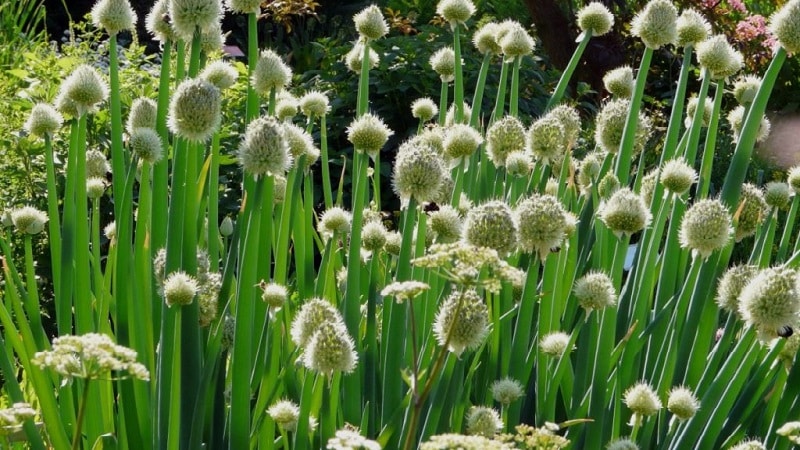
Frozen product is stored in the freezer for about a year. The green feather can be stored in the vegetable compartment of the refrigerator for a month.
Onions are suitable for drying in the oven, electric dryer and outdoors. Dry raw materials are stored in paper bags or glass containers for up to a year.
Conclusion
The frost resistance of onions is amazing. The plant can withstand bitter frosts down to -45°C. This feature allows you to plant it in October - November, down to a soil temperature of -3°C, and in March - April to collect the first vitamin greens. Batun grows in the same place without loss of quality for up to 4-5 years, so there is no need to increase the fertility of the site annually.
The seeds overwinter under a thick layer of mulch and black agrofibre, and after the snow melts they sprout. In winter, planting care is not required; in spring, standard agricultural practices are performed - watering, loosening, weeding, protection from diseases and pests.